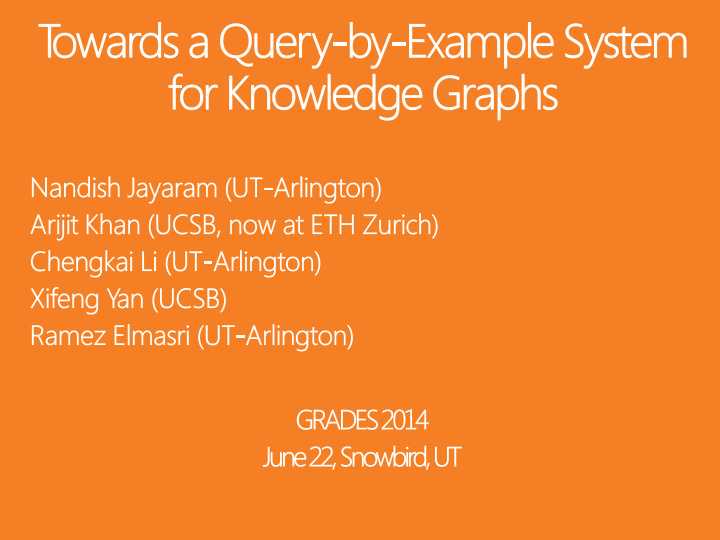



Knowledge Graphs Large ge and complex plex graphs capturing millions of entities and relationships between them! Entity Relationship Ubiqu quitous itous toda day: y: Linking Open Data Freebase DBpedia YAGO
How to Query Knowledge Graphs? Graph Search / Structured Querying F.prop = ‘founded’ AND G.prop = ‘education AND H.prop = ‘ headquartered_in ’ AND L.prop = ‘ places_lived ’ AND P .prop = ‘ place_founded ’ AND F.obj = H.src AND F.obj = P .src AND F.src = L.src AND L.obj = H.obj AND F.src = G.src Expertise in constructing structured queries required. A good knowledge of the schema of the knowledge graph is required.
Improving Usability of Knowledge Graphs: Prior Arts Keyword Search “Software companies located in the Silicon Valley and their founders who studied at Stanford University. ” Keyword search on graphs [Karger11]. Keyword based query formulation [Pound10] [Y ao12]. Natural Language Query Natural language questions based querying [Y ahya12]. Visual Query Interfaces Interactive and form based query construction [Demidova12] [Jarrar12]. Visual interface for query graph construction [Chau08] [Jin10]. Schemaless Graph Querying Use transformations to find matches to a naïve query graph [Y ang14].
Query by Example Entity T uples Given an input n -entity tuple(s) (called n -tuple), a knowledge graph, and k , find top- k n -tuples that are most similar to the input tuple(s). Input Tuple
Answer T uples Input T uple : Donald Knuth, Stanford University, T uring Award
Overall Architecture Query lattice to Find approximate model space of all matching answers Discover an hidden approximate matches. to the MQG. query graph behind the input tuples. Obtain user feedback to better understand the query intent. Exemplar Queries [Mottin14]
Maximal Query Graph Discovery Given an example tuple like <Jerry Yang, Yahoo!> Define importance of edges by assigning weights to them. Find a small sub-graph with important edges and nodes in the neighborhood of Jerry Y ang and Y ahoo!, to form the Maximal Query Graph (MQG).
Answer Space Modeling Every other node is a sub-graph of the MQG.
Query Processing Pruning nodes based Upper bound based bottom- on null nodes. up lattice exploration. Lattice evaluation terminated after top-k answers are obtained!
Finding Matching Answer Graphs Exact sub-graph matching, based on indexing techniques. Search on graph databases [Shasha02] [Yan04] [Zhao07] [Zou08]. Search on single large graph [Ullman76] [Cordella04] [Shang08] [Zhang09]. Approximate sub-graph matching. Use various indexes to quickly find approximate matches [Tian08] [Mongiovi10] [Khan13]. NESS : uses neighborhood-based indexes to quickly find approximate matches to a query graph [Khan11].
Experiments QUERIES: 20 Queries on Freeba ebase se dataset (47 M edges, 27 M nodes, 5.4 K properties) 8 Queries on DBped pedia ia dataset (2.6 M edges, 759 K nodes, 9 K properties) Accuracy Comparison with NESS:
Efficiency Results Single Query Execution Times (in seconds) 1000 Query Processing Time (secs.) GQBE NESS Baseline 100 10 1 F1 F2 F3 F4 F5 F6 F7 F8 F9 F10 F11 F12 F13 F14 F15 F16 F17 F18 F19 F20 # edges 12 13 18 10 8 10 8 12 8 8 10 11 9 7 7 11 8 9 7 9 in MQG Query
Work in Progress Maximal Query Graph Discovery: Does not capture the user-intent exactly. Iterative and interactive edge suggestion. Query Processing: Materializing intermediate join results (millions of rows) can be expensive. Is a better join mechanism when we have more memory at our disposal possible? Distributed lattice exploration mechanism. Obtaining User Feedback: User feedback on relevance of answer tuples to re-weight edges.
Work by Xifeng Yan’s group at UCSB (VLDB 2014) (ICDE 2013) (SIGMOD 2014 demo, VLDB 2014)
Demo and T echnical Details: Demo: URL: idir.uta.edu/gqbe Demo paper: GQBE: Querying knowledge graphs by example entity tuples , ICDE 2014. T echnical Details: Full paper under review Archived version: http://arxiv.org/abs/1311.2100
Recommend
More recommend